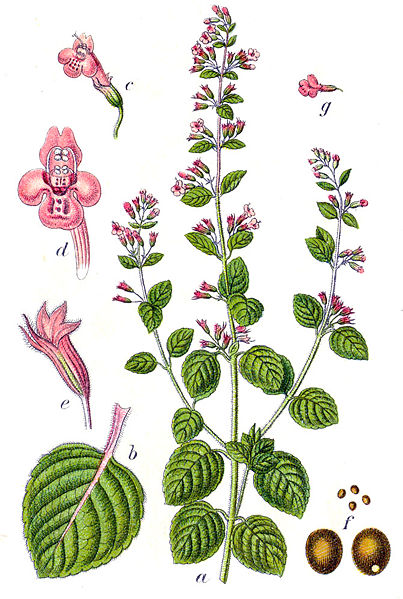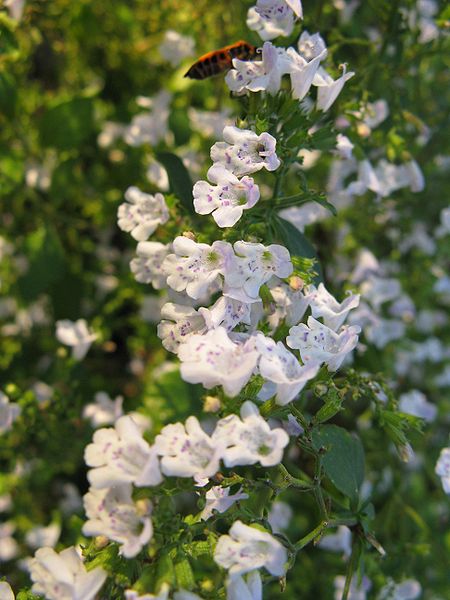 |
|
http://commons.wikimedia.org/wiki/File:Calamintha_nepeta_Sturm54.jpg |
 |
| http://commons.wikimedia.org/wiki/User:KENPEI |
Translate this page:
Summary
Physical Characteristics

 Calamintha nepeta is a PERENNIAL growing to 0.6 m (2ft) by 0.8 m (2ft 7in).
Calamintha nepeta is a PERENNIAL growing to 0.6 m (2ft) by 0.8 m (2ft 7in).
See above for USDA hardiness. It is hardy to UK zone 6 and is not frost tender. It is in flower from July to September, and the seeds ripen from September to October. The species is hermaphrodite (has both male and female organs) and is pollinated by Bees, insects.
It is noted for attracting wildlife.
Suitable for: light (sandy) and medium (loamy) soils and prefers well-drained soil. Suitable pH: neutral and basic (mildly alkaline) soils and can grow in very alkaline soils.
It cannot grow in the shade. It prefers dry or moist soil.
UK Hardiness Map
US Hardiness Map
Synonyms
Satureia nepeta.
Plant Habitats
Cultivated Beds;
Edible Uses
Edible Parts:
Edible Uses: Condiment Tea
The leaves have a strong pennyroyal-like fragrance and are more pungent than calamint (C. sylvatica)[183]. They can be used as a flavouring[183]. A sweet and aromatic herb tea is made from the leaves[200].
References More on Edible Uses
Medicinal Uses
Plants For A Future can not take any responsibility for any adverse effects from the use of plants. Always seek advice from a professional before using a plant medicinally.
Aromatic Diaphoretic Expectorant Febrifuge Stomachic
Lesser calamint was commonly used as a medicinal herb in medieval times, though is little used by modern herbalists[238]. It is sometimes cultivated as a medicinal herb for household use. The whole plant is aromatic, diaphoretic, expectorant, febrifuge and stomachic[4, 148]. The leaves are harvested in July as the plant comes into flower and are dried for later use[4]. An infusion is beneficial in cases of flatulent colic and weaknesses of the stomach[4], it is also used to treat depression, insomnia and painful menstruation[238]. It should not be prescribed for pregnant women since in excess it can cause a miscarriage[238].
References More on Medicinal Uses
The Bookshop: Edible Plant Books
Our Latest books on Perennial Plants For Food Forests and Permaculture Gardens in paperback or digital formats.

Edible Tropical Plants
Food Forest Plants for Hotter Conditions: 250+ Plants For Tropical Food Forests & Permaculture Gardens.
More

Edible Temperate Plants
Plants for Your Food Forest: 500 Plants for Temperate Food Forests & Permaculture Gardens.
More

More Books
PFAF have eight books available in paperback and digital formats. Browse the shop for more information.
Shop Now
Other Uses
References More on Other Uses
Cultivation details
Prefers a well-drained dry to moist neutral to alkaline soil and a warm sunny position[200, 238]. Plants are hardy to about -15°c[187]. This species is very closely related to C. sylvatica, and is considered to be no more than a sub-species by some botanists[4]. A very good bee plant[187]. The plant is heat tolerant in zones 9 through 5. (Plant Hardiness Zones show how well plants withstand cold winter temperatures.
Plant Heat Zones show when plants would start suffering from the heat.
The Plant Heat Zone map is based on the number of "heat days" experienced in a given area where the temperature climbs to over 86 degrees F (30°C).
At this temperature, many plants begin to suffer physiological damage. Heat Zones range from 1 (no heat days) to 12 (210 or more heat days).
For example Heat Zone. 11-1 indicates that the plant is heat tolerant in zones 11 through 1.) For polyculture design as well as the above-ground architecture (form - tree, shrub etc. and size shown above) information on the habit and root pattern is also useful and given here if available. The plant growth habit is a runner spreading indefinitely by rhizomes or stolons [1-2]. The root pattern is stoloniferous rooting from creeping stems above the ground [1-2].
References Carbon Farming Information and Carbon Sequestration Information
Temperature Converter
Type a value in the Celsius field to convert the value to Fahrenheit:
Fahrenheit:
The PFAF Bookshop
Plants For A Future have a number of books available in paperback and digital form. Book titles include Edible Plants, Edible Perennials, Edible Trees,Edible Shrubs, Woodland Gardening, and Temperate Food Forest Plants. Our new book is Food Forest Plants For Hotter Conditions (Tropical and Sub-Tropical).
Shop Now
Plant Propagation
Seed - sow spring in a greenhouse and only just cover the seed. It usually germinates in 2 weeks at 21°c[138]. Prick out the seedlings when they are large enough to handle and, if they grow sufficiently, plant them out into their permanent positions in the summer otherwise wait until the following spring. Division in spring. Very easy, larger clumps can be planted direct into their permanent positions. It is best to pot up smaller clumps and grow them on in a cold frame until they are well rooted before planting them out in the summer. Basal cuttings in May or June. They should be rooted in a sandy compost[245]. Harvest the shoots when they are about 10 - 15cm long with plenty of underground stem. Pot them up into individual pots and keep them in light shade in a cold frame or greenhouse until they are rooting well. Plant them out in the summer.
Other Names
If available other names are mentioned here
Native Range
TEMPERATE ASIA: Armenia, Azerbaijan, Ciscaucasia, Dagestan, Georgia, Russian Federation, Russian Federation-Ciscaucasia, Turkey,Iran. EUROPE: United Kingdom (U.K.), England (east), Austria, Switzerland, Hungary, Moldova, Ukraine (incl. Krym), Former Yugoslavia, Albania, Bulgaria, Greece (incl. Crete), Italy (incl. Sardinia, Sicily), Spain (incl. Baleares), France (incl. Corsica), AFRICA: Algeria, Morocco, Tunisia.
Weed Potential
Right plant wrong place. We are currently updating this section.
Please note that a plant may be invasive in one area but may not in your area so it's worth checking.
Conservation Status
IUCN Red List of Threatened Plants Status :

Growth: S = slow M = medium F = fast. Soil: L = light (sandy) M = medium H = heavy (clay). pH: A = acid N = neutral B = basic (alkaline). Shade: F = full shade S = semi-shade N = no shade. Moisture: D = dry M = Moist We = wet Wa = water.
Now available:
Food Forest Plants for Mediterranean Conditions
350+ Perennial Plants For Mediterranean and Drier Food Forests and Permaculture Gardens.
[Paperback and eBook]
This is the third in Plants For A Future's series of plant guides for food forests tailored to
specific climate zones. Following volumes on temperate and tropical ecosystems, this book focuses
on species suited to Mediterranean conditions—regions with hot, dry summers and cool, wet winters,
often facing the added challenge of climate change.
Read More
Expert comment
Author
(L.)Savi.
Botanical References
17200
Links / References
For a list of references used on this page please go here
Readers comment